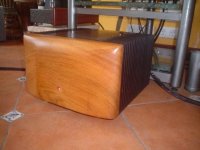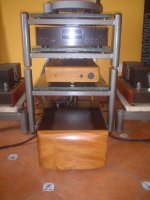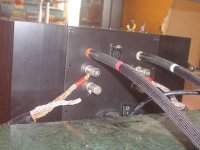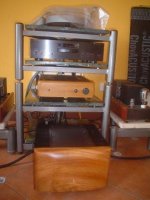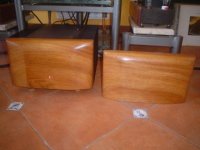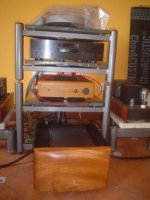I don't understand why, but I'm having a very interesting situation here.
As I wrote in earlier posts, I used to have temperature issues: my grey 30x24x4 cm heatsinks became scorchin' hot, after a couple hours or more, even at a bias point of around 210 mV.
I learnt that heatsinks rely a lot upon irradiation, and they should be black for best efficiency. So I managed to have them anodized in black for free.
Put the amp together again, fired it up at 250 mV target. About the same high temperature I felt before at 210 mV... An improvement, but I hoped it would have become better (to reach 300 mV).
After a few days of use, I touched it again and felt it was cooler. Now I can handle 300 mV across the power resistors, while keeping my hand on it forever. Surely hot, but not so much as before.
So, it seems there's something I miss... How is it possible that the overall behaviour has changed in a few days? Maybe the black anodization has a "burn-in" time before "melting" into the aluminium and work properly? (I hardly believe it's true)
I can't understand why, in the first day of "black", I had a scorchin' hot amp at .5A, and now I have a warm/hot one at .6A.
Surely I'm very happy, it's finally over and working at full specs.
😎
Giacomo
As I wrote in earlier posts, I used to have temperature issues: my grey 30x24x4 cm heatsinks became scorchin' hot, after a couple hours or more, even at a bias point of around 210 mV.
I learnt that heatsinks rely a lot upon irradiation, and they should be black for best efficiency. So I managed to have them anodized in black for free.
Put the amp together again, fired it up at 250 mV target. About the same high temperature I felt before at 210 mV... An improvement, but I hoped it would have become better (to reach 300 mV).
After a few days of use, I touched it again and felt it was cooler. Now I can handle 300 mV across the power resistors, while keeping my hand on it forever. Surely hot, but not so much as before.
So, it seems there's something I miss... How is it possible that the overall behaviour has changed in a few days? Maybe the black anodization has a "burn-in" time before "melting" into the aluminium and work properly? (I hardly believe it's true)
I can't understand why, in the first day of "black", I had a scorchin' hot amp at .5A, and now I have a warm/hot one at .6A.
Surely I'm very happy, it's finally over and working at full specs.
😎
Giacomo
giacomo_pagani said:I don't understand why... So, it seems there's something I miss... Surely I'm very happy, it's finally over and working at full specs...
Giacomo
Are you sure?
Yes, black will help but I beleive the benifit will not be more than 5-10% at most 😉
Radiation... Yes, that's how it works. Is the amp in a more open air atmosphere now than your original temp measurements?
There is very little that would "break in" to make temp lower and nothing that would cause a change as much as you seem to be describing???
Are you measuring all the source Rs or just one?
Are you waiting the same time before you take a temp measurement. The profile of temp probably rises fast at first and overshoots then goes down then back up etc...
You might consider measuring the R of your source Rs cold, and then again hot. And then, measure the voltage drop on them again 😀
Can you actually drive the output with a resistor load and swing the voltage(current) you expect???
It is more likely the excessive heat has changed a component permanatly only making the actuall current lower, not actually lowering the temp with the correct current.
😀
Hi guys,
It takes me over a month to go through the whole thread, from page 1 to 106.
I thought F4 surely is a amazing amp to build. Would somebody point me to where I could get couple boards to start?
Thanks
Albert
It takes me over a month to go through the whole thread, from page 1 to 106.
I thought F4 surely is a amazing amp to build. Would somebody point me to where I could get couple boards to start?
Thanks
Albert
Peter Daniel from Canada is the only source I've seen for F4 PCB's, other than making your own. Last I saw he had long since sold out of the first runs though. Look on the "WTB: F4 PCB" thread.albertli said:Hi guys,
It takes me over a month to go through the whole thread, from page 1 to 106.
I thought F4 surely is a amazing amp to build. Would somebody point me to where I could get couple boards to start?
Thanks
Albert
New F4
Hello to all.
This is my first F4, the second one is in way. This one is not finished completely but irun perfectly.
Thanks to Nelson and all people who helped me.
Jose
Hello to all.
This is my first F4, the second one is in way. This one is not finished completely but irun perfectly.
Thanks to Nelson and all people who helped me.
Jose
José Humberto said:One pic
José Humberto said:Another
José Humberto said:And another one.
Best regards
fugly!
fugly!
fugly!

José Humberto said:Thank you a lot.
Thank you a lot.
Thank you a lot.
feel free to send me first one in high res ;
it's really wort having 😉
my addy is >choky@neobee.net<
José Humberto said:I for got it.
The cover to turn table still for sale.
OK - send me that cover in e-mail , and I'll pay you via Paypal ;
that's OK ?

OK - send me that cover in e-mail , and I'll pay you via Paypal ;
I promise send some cds too. Hehehe
🙂
The another front.
Attachments
José
Nice work hombre, send us a few pic's of the inside porfavor 😉
Looks great!
Saludos.
Audiofanatic 😉
Nice work hombre, send us a few pic's of the inside porfavor 😉
Looks great!
Saludos.
Audiofanatic 😉
- Home
- Amplifiers
- Pass Labs
- F4 power amplifier
